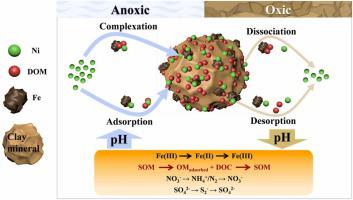Journal of Hazardous Materials ( IF 12.2 ) Pub Date : 2023-03-21 , DOI: 10.1016/j.jhazmat.2023.131246 Kaiyi Huang 1 , Yang Yang 2 , Hansha Lu 1 , Shiwen Hu 2 , Guojun Chen 2 , Yanhong Du 2 , Tongxu Liu 2 , Xiaomin Li 3 , Fangbai Li 2

|
Nickel is generally released from flooded soils; however, the key Ni transformation processes in soils that are freshly contaminated by Ni2+ during anoxic–oxic alteration remain unclear. We developed a kinetic model to investigate the Ni transformation in paddy soils under anoxic and oxic conditions based on the results of the seven-step sequential extraction, determination of dissolved and soil organic matter, and surface site quantification, which provide the kinetic data of different Ni fractions, organic matter, and reactive sites for modeling. The dissolved, exchangeable, and specifically adsorbed Ni was gradually transferred to fulvic complex, humic complex, Fe–Mn oxide bound, and sulfide bound Ni after 40 d of anoxic incubation due to the increase in pH and soil surface sites, which were mainly induced by Fe(III) oxide reduction and soil organic matter release. The introduction of oxygen triggered a rapid release of Ni, which was ascribed to the decrease in pH and soil surface sites caused by Fe(II) oxidation and carbon re-immobilization. Kinetic modeling demonstrated that complexation with soil organic matter dominated Ni immobilization under anoxic conditions, while organic matter and Fe–Mn oxides contributed similarly to Ni release under oxic conditions, although the majority of Ni remained complexed with soil organic matter. These findings are important for the evaluation and prediction of Ni behavior in paddy soils with exogenous Ni during flooding-drainage practices.
中文翻译:

缺氧-好氧蚀变过程中外源镍在水稻土中的转化动力学:有机质和氧化铁的作用
镍通常从被淹没的土壤中释放出来;然而,新近被 Ni 2+污染的土壤中的关键 Ni 转化过程在缺氧 - 氧化变化期间仍不清楚。我们基于七步顺序提取、溶解性和土壤有机质的测定以及表面位点定量的结果,开发了一个动力学模型来研究缺氧和有氧条件下水稻土中镍的转化,该模型提供了不同的动力学数据用于建模的 Ni 组分、有机物和反应位点。缺氧培养 40 d 后,由于 pH 和土壤表面位点的增加,溶解的、可交换的和特异性吸附的 Ni 逐渐转移到黄腐复合物、腐殖复合物、Fe-Mn 氧化物结合和硫化物结合的 Ni,这主要是诱导的通过 Fe(III) 氧化物还原和土壤有机质释放。氧气的引入引发了 Ni 的快速释放,这归因于 Fe(II) 氧化和碳再固定引起的 pH 值和土壤表面位点的降低。动力学模型表明,在缺氧条件下,与土壤有机质的络合主导了 Ni 的固定,而在有氧条件下,有机质和 Fe-Mn 氧化物对 Ni 释放的贡献相似,尽管大部分 Ni 仍与土壤有机质络合。这些发现对于评价和预测漫灌过程中外源 Ni 水稻土中的 Ni 行为具有重要意义。尽管大部分 Ni 仍与土壤有机质复合。这些发现对于评价和预测漫灌过程中外源 Ni 水稻土中的 Ni 行为具有重要意义。尽管大部分 Ni 仍与土壤有机质复合。这些发现对于评价和预测漫灌过程中外源 Ni 水稻土中的 Ni 行为具有重要意义。











































 京公网安备 11010802027423号
京公网安备 11010802027423号